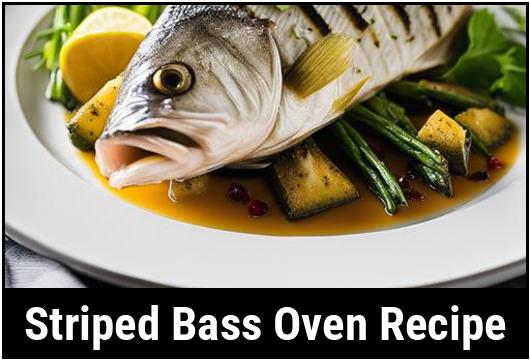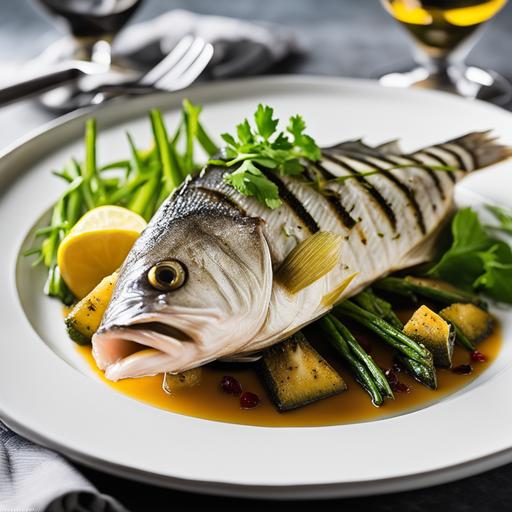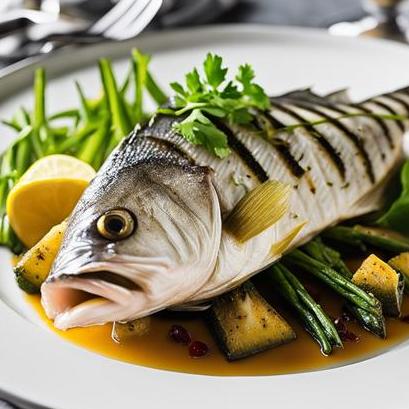
Striped Bass Oven Recipe: A Delectable Delight For Seafood Enthusiasts
Are you craving a tantalizing seafood dish that will leave your taste buds dancing with joy? Look no further than this comprehensive guide on preparing a succulent striped bass in the oven. In this article, we will explore the food science behind the flavors, discover culinary details that enhance the dish, discuss the selection, cleaning, and preparation process, provide useful tips, suggest variations, explain doneness checks, and finally, present you with a delectable recipe to satisfy your cravings.
The Science Behind the Flavors: Understanding Striped Bass
Before diving into the culinary aspects of cooking striped bass, it’s essential to understand the fish itself. Striped bass, also known as striper or rockfish, is a highly esteemed saltwater fish found in the Atlantic Ocean. It boasts a firm and flavorful white flesh known for its delicate yet distinct taste.
The flavors within a striped bass come from the unique combination of proteins, fats, and minerals present in its flesh. This fish contains an impressive amount of omega-3 fatty acids, known for their heart-healthy benefits. Striped bass also provides essential nutrients like phosphorus and selenium, contributing to overall well-being.
Culinary Details: Enhancing the Flavors of Striped Bass
Cooking striped bass in the oven is a fantastic way to preserve the fish’s delicate flavors while adding a crispy, golden crust. Here are some crucial culinary details to elevate your striped bass dish:
Seasoning
To enhance the natural flavors of striped bass, keep the seasoning simple. A combination of salt, pepper, and a sprinkle of dried herbs like thyme or dill can complement the fish’s taste without overpowering it.
Marinades and Rubs
Marinating the striped bass with a blend of olive oil, lemon juice, garlic, and herbs can infuse the fish with additional flavors. Alternatively, dry rubs, comprising spices like paprika, cayenne pepper, and onion powder, contribute a mildly spicy kick. Allow the fish to marinate or rest with the rub for at least 30 minutes to allow the flavors to penetrate the flesh.
Sauces
Pairing your striped bass with a delectable sauce can further elevate your culinary experience. Consider serving it with a lemon-butter sauce or a creamy dill sauce for a refreshing and tangy accent. Be creative and experiment with your favorite flavors to craft a sauce that perfectly complements the rich taste of the striped bass.
Selection, Cleaning, and Preparation: Ensuring Freshness and Quality

To guarantee the best outcome for your striped bass oven recipe, it’s crucial to select fresh fish, clean it properly, and prepare it adequately.
Selecting Fresh Fish
When buying striped bass, go for whole fish or fillets that have shiny skin and clear, bright eyes. The flesh should be firm, resilient to pressure, and emit a sweet, clean aroma of the sea. If opting for fillets, they should be evenly colored without any signs of discoloration or dryness.
Cleaning the Fish
To clean the fish properly, rinse it under cold water and pat it dry with paper towels. Using a sharp knife, remove any scales remaining on the skin by scraping from tail to head. Next, make an incision along the belly and remove the guts, ensuring not to puncture the bile sac. Rinse the cavity thoroughly to remove any remaining blood or debris.
Preparing the Fish
Once the fish is cleaned, it’s time to prepare it for cooking. If you prefer a whole striped bass, stuff the cavity with lemon slices, herbs, and onions to infuse the flavors during cooking. Alternatively, if using fillets, cut them to standard portions to ensure even cooking.
Tips for Perfectly Cooked Striped Bass

Achieving the ideal texture and doneness when cooking striped bass requires careful attention and adherence to a few essential tips:
Oven Temperature
Preheating the oven is crucial to ensure the striped bass cooks evenly. Set the oven to 375°F (190°C) for best results.
Cooking Time
The cooking time for striped bass can vary depending on the fish’s thickness and the chosen cooking method. As a general rule, bake the fish for around 10-12 minutes per inch of thickness. However, using a meat thermometer to check the internal temperature is the most accurate way to determine doneness. Aim for an internal temperature of 145°F (63°C) for perfectly cooked striped bass.
Doneness Check
To check if your striped bass is cooked, insert a meat thermometer into the thickest part of the fish, avoiding contact with the bone. The fish should be opaque and flake easily with a fork once cooked.
Resting Time
Allow the cooked striped bass to rest for a few minutes before serving. This resting period ensures the juices redistribute within the fish, resulting in a moist and tender texture.
Pairing and Serving
When serving your perfectly cooked striped bass, consider pairing it with fresh lemon wedges or a light citrus salad to add a refreshing acidity. Accompany it with roasted vegetables, herbed rice, or crusty bread to complete your delicious meal.
Delicious Striped Bass Oven Recipe
Now that you’ve learned about the food science, culinary details, selection, cleaning, preparation tips, and doneness checks, it’s time to savor this exquisite striped bass oven recipe:
Ingredients:
-
2 pounds striped bass fillets
-
2 tablespoons olive oil
-
2 tablespoons lemon juice
-
2 cloves garlic, minced
-
1 teaspoon dried thyme
-
Salt and pepper, to taste
Instructions:
-
Preheat the oven to 375°F (190°C) and line a baking sheet with foil or parchment paper.
-
Rinse the striped bass fillets under cold water and pat them dry with paper towels.
-
In a small bowl, combine the olive oil, lemon juice, minced garlic, dried thyme, salt, and pepper to create a marinade.
-
Place the striped bass fillets on the prepared baking sheet and brush them generously with the marinade, making sure to coat both sides.
-
Allow the fish to marinate for at least 30 minutes or let it rest with the marinade for up to 2 hours in the refrigerator for intense flavors.
-
Transfer the baking sheet to the preheated oven and bake the fish for approximately 10-12 minutes per inch of thickness.
-
Check the doneness by inserting a meat thermometer into the thickest part of the fish without touching the bone. The internal temperature should read 145°F (63°C) for perfectly cooked striped bass.
-
Once cooked, remove the baking sheet from the oven and let the fish rest for a few minutes to allow the flavors to meld.
-
Serve the striped bass fillets with your preferred side dishes, garnish with fresh herbs, and enjoy the delectable flavors!
Variations to Delight Your Palate
While the above-mentioned recipe is a classic approach to preparing striped bass in the oven, feel free to add your own twist and experiment with various flavor combinations. Here are a few variations to inspire your culinary creativity:
-
Asian-inspired: Marinade the fish with soy sauce, ginger, lime juice, and a touch of honey. Serve alongside steamed bok choy and jasmine rice for a delightful fusion dish.
-
Mediterranean flair: Season the striped bass with olive oil, minced garlic, dried oregano, and lemon zest. Serve it with a fresh tomato and cucumber salad drizzled with balsamic glaze.
-
Spicy Cajun: Create a rub using paprika, cayenne pepper, garlic powder, and black pepper. Bake the fish until perfectly cooked and serve it with a side of creamy coleslaw and cornbread for a Southern twist.
Feel free to adapt these variations to suit your personal taste preferences and unleash your culinary artistry.
With this comprehensive guide, you are now equipped with the knowledge and techniques to masterfully prepare a delectable striped bass dish in the oven. From understanding the science behind the flavors to selecting the freshest fish, cleaning it with precision, and achieving the perfect doneness, your seafood culinary journey is bound to be a resounding success. So, heat up your oven and embark on this delicious adventure of cooking striped bass for a memorable dining experience. Bon appétit!
Sources
FAQS On Striped Bass Oven Recipe
What Is A Good Oven Recipe For Cooking Striped Bass?
One delicious oven recipe for cooking striped bass is to bake it with lemon and herbs. The lemon adds a refreshing citrus flavor, while the herbs infuse the fish with aromatic undertones.
How Long Should I Bake Striped Bass In The Oven?
The cooking time for baking striped bass in the oven depends on the thickness of the fillets. As a general guideline, bake the fish at a preheated oven of 400°F (200°C) for about 12-15 minutes per 1 inch (2.5 cm) of thickness. Ensure to check that the internal temperature reaches 145°F (63°C) to guarantee it is fully cooked.
Can I Use Frozen Striped Bass For This Oven Recipe?
Yes, you can use frozen striped bass for this oven recipe. However, it is best to thaw the fish completely before cooking to ensure even cooking and optimal flavor. Thaw the fish in the refrigerator overnight or use the defrost setting on your microwave if you’re short on time.
What Are Some Recommended Seasonings To Use With Striped Bass In The Oven?
Along with lemon and herbs, you can enhance the flavor of striped bass by adding spices like paprika, garlic powder, onion powder, or a pinch of cayenne pepper for a little kick. Additionally, salt and black pepper are basic seasonings that can be adjusted to taste.
Should I Cover The Baking Dish When Cooking Striped Bass In The Oven?
It is not necessary to cover the baking dish when cooking striped bass in the oven. Baking the fish uncovered allows the heat to circulate evenly, resulting in a nicely browned and crispy exterior. However, if you notice the fish browning too quickly, you can loosely cover it with foil to prevent excessive browning or drying.


